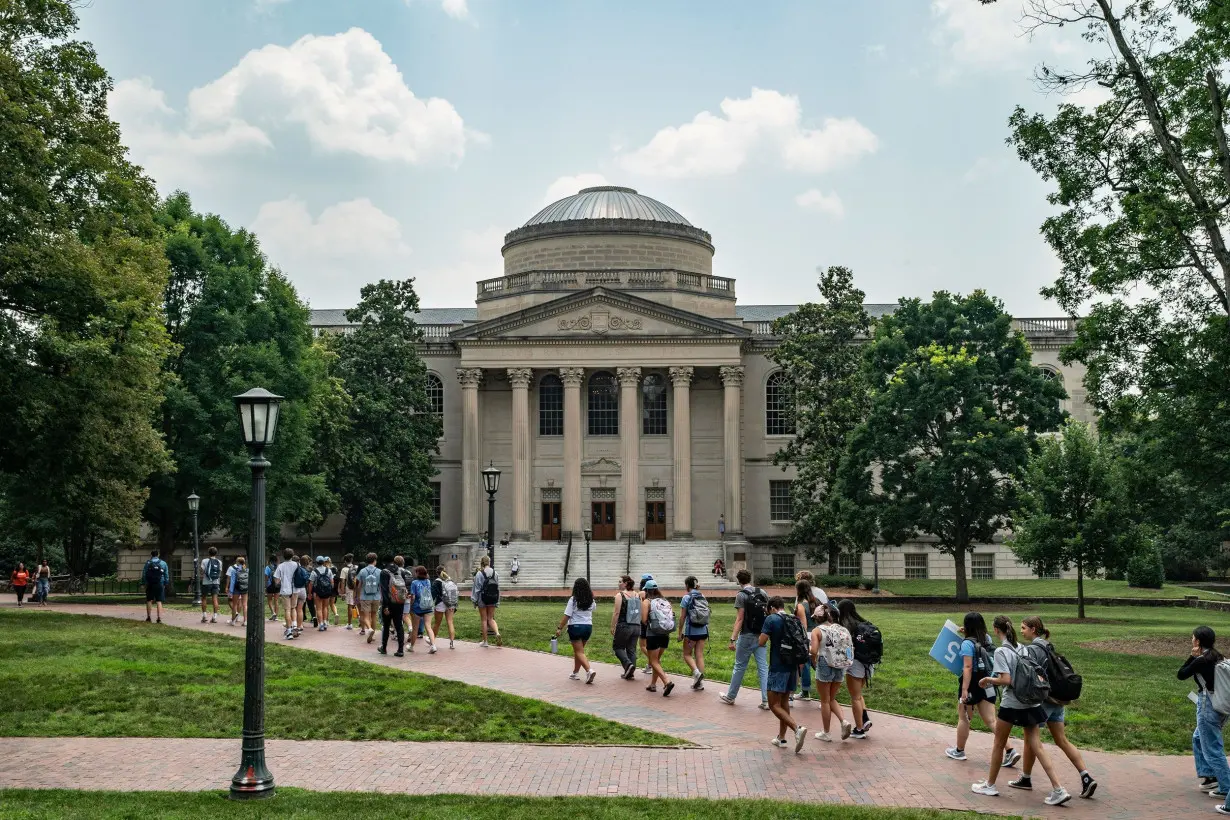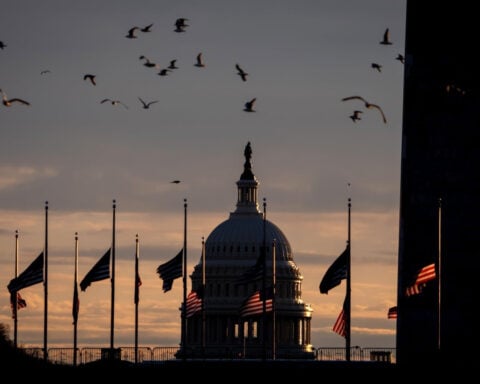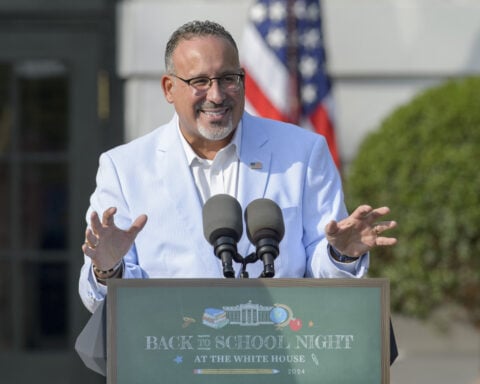(CNN) — Samantha Greene, a junior at the University of North Carolina at Chapel Hill, said she quickly noticed a difference in the student body when she stepped on campus in August.
As president of the Black Student Movement at the state’s flagship university, Greene said this year’s Black Student Convocation, an event that welcomes first year students and connects them to resources on campus, was much smaller than it’s been in the past.
“We’ve definitely noticed a significant decrease in not just attendance, but in the presence of Black students on campus,” Greene said. “We know each other, we talk to each other and there is just less of them.”
Last week, UNC Chapel Hill released a profile of incoming freshman and transfer students that shows in the year since the US Supreme Court gutted affirmative action in college admissions, the number of Black students admitted to the university dropped from 10.5% to 7.8% – a decrease of around 25%.
Harvard University also experienced a similar drop in Black enrollment, according to data released this week which shows a 22% decrease in Black freshmen when compared to the year before. Both schools were named as plaintiffs in the Supreme Court case that ended the long-held practice of considering race and ethnicity in college admissions.
“I chose this school because I saw the robust amount of diversity that was here and the results of it as well,” Greene said of UNC. “So, to see that kind of go a little bit down the gutter definitely has me thinking about my choice to be here.”
As admissions offices across the country release their latest racial demographics, a murky portrait is beginning to emerge of the Class of 2028 – one that’s left some experts warning about the long-term effects of a lack of diversity on campus.
College diversity seesaws across the country
Ending affirmative action has had an uneven impact on admissions to some of the most highly selective and competitive universities in the country.
At Yale University, the percentage of Black students admitted this year held steady at 14% when compared to those who started last fall, but the number of Asian students fell by 20% compared to last year.
At UNC, despite the decline in Black students admitted, the percentage of Asian and Native Hawaiian Pacific Islander students saw a slight increase.
And at the Massachusetts Institute of Technology, the number of Black students admitted to the Class of 2028 collapsed from 15% last fall to just 5% this year, while Latino students saw a 31% decrease.
In an interview with the university’s news outlet last month, Stu Schmill, MIT’s dean of admissions, said the change in demographics reflects the impact of the Supreme Court’s ruling.
The Class of 2027 had the “highest proportion of students from historically underrepresented racial and ethnic backgrounds in MIT history,” he said, and the university used race as a factor in identifying “well-prepared students who emerged from the unequal K-12 educational environment.”
But after the ruling, Schmill said he has “no doubt that we left out many well-qualified, well-matched applicants from historically under-represented backgrounds who in the past we would have admitted — and who would have excelled.”
Further complicating the picture, many universities have also noted that since the end of affirmative action, students are now given the option to self-report their race on their applications and some have declined, skewing the demographic data available.
The sharp drop in Black students admitted to UNC Chapel Hill sparked a swift outcry from students and alumni. In a news conference following the release of the data, Rachelle Feldman, vice provost of enrollment at the university, said it is too soon to know if the changes in demographics are a pattern.
“At Chapel Hill we’re following the law in every way in our admissions process but we also take very seriously our service to the state and trying to reach students and applicants in all 100 counties and make sure that anyone from any background within North Carolina or beyond that earns their way here… finds themselves welcomed and supported and able to thrive,” Feldman said.
William R. Fitzsimmons, Harvard university’s dean of admissions and financial aid, made a similar commitment as he sought to reassure the campus and the wider public that the Ivy League school remains determined to foster a diverse student body.
“Our community is strongest when we bring together students from different backgrounds, experiences, and beliefs,” he said in a statement. “And our community excels when those with varied perspectives come together – inside and outside of the classroom – around a common challenge by seeing it through another’s perspective.”
But for Ed Blum, the legal activist whose lawsuit against Harvard and UNC ultimately ended collegiate affirmative action practices, the impact of the court decision is not clear-cut. Blum told CNN in an email he believes the Supreme Court’s ruling “has greatly benefited all college students.”
“The easiest part of my job is persuading my fellow Americans that a student’s race should not be used as a factor in college admissions,” Blum said. “In dozens of polls — Gallop, Pew Research, New York Times and others — significant majorities of all Americans of every race do not believe a student’s race should be used in college admissions.”
Affirmative action bans have lasting impact
History shows ending affirmative action can have long-term economic repercussions for students of color. Backlash to affirmative action policies reached a fever pitch in the 1990s, leading several states, including Texas, Washington, Florida and California, to enact bans on race-conscious admissions policies.
Zachary Bleemer, an economics professor at Princeton University who studies the impact of affirmative action bans, said the bans passed in the 1990s – similar to today – had an immediate effect on the diversity of the student body.
When California ended affirmative action in 1998, what “you saw was this immediate decline between 40 and 50% of Black and Hispanic enrollment at Berkeley and UCLA, the two most selective schools in the state,” Bleemer said.
Bleemer’s research also tracked the lasting effects of the ban over the next decade and found that more than 1,000 fewer students from underrepresented minority groups applied to University of California schools each year.
For Black and Hispanic students, losing access to California’s most selective colleges and universities also had long-term economic consequences.
“When affirmative action bans are put into place, Black and Hispanic students flow into less selective universities, and as a result, become a little bit less likely to earn a college degree, earn a degree in a lucrative STEM field, or in a graduate degree,” he said.
“If you follow them forward to the labor market, you see meaningful decline from the order of 5 or 6% of wages that disappear because they end up going to a less selective school instead.”
But in the years since these bans were implemented, Bleemer said schools have found ways to maintain diversity through race-neutral admissions policies. In states like Texas and Florida, top-tier admissions policies guarantee automatic acceptance into state schools for students who graduate high school in the top 10% and 20% of their classes respectively.
Other schools, like those in California, have adopted a holistic approach to admissions that places less emphasis on test scores and instead views the applicant’s qualifications in their entirety. These programs tend to increase Black and Hispanic student enrollment, Bleemer said, though not to the same degree as race-conscious affirmative action policies.
Ultimately, Bleemer said, he feels the end of affirmative action presents American colleges and universities with a chance to realign their admissions process with their values.
“Universities, I think in many cases, realize themselves how impactful the ban has been, and reconsider what they want the composition of their university to look like, and implement policies – race-neutral policies – that better reflect their admissions interests,” he said.
And for Greene, the sudden change in her student body is also a chance for student organizations like the Black Student Movement to make their voices and their concerns heard.
“I think it’s really important that people know and see how collective we are,” she said. “I just fear that the community is no longer driving UNC. It is now a limited amount of individuals in a high position of power that are changing what UNC means to students, and I do worry for the university – but it doesn’t change my mind about coming here.”
The-CNN-Wire
™ & © 2024 Cable News Network, Inc., a Warner Bros. Discovery Company. All rights reserved.

 Stock market today: Asian stocks mixed ahead of US inflation data
Stock market today: Asian stocks mixed ahead of US inflation data
 TikTok seeks to reassure U.S. employees ahead of Jan. 19 ban deadline
TikTok seeks to reassure U.S. employees ahead of Jan. 19 ban deadline
 US won't seek charges in unarmed Black motorist Ronald Greene's fatal 2019 arrest
US won't seek charges in unarmed Black motorist Ronald Greene's fatal 2019 arrest
 Euro zone households could increase consumption, ECB chief economist says
Euro zone households could increase consumption, ECB chief economist says
 Foreigners sold South Korean equities last month by most since early 2020
Foreigners sold South Korean equities last month by most since early 2020
 As fires ravage Los Angeles, Tiger Woods isn't sure what will happen with Riviera tournament
As fires ravage Los Angeles, Tiger Woods isn't sure what will happen with Riviera tournament
 Antetokounmpo gets 50th career triple-double as Bucks win 130-115 to end Kings' 7-game win streak
Antetokounmpo gets 50th career triple-double as Bucks win 130-115 to end Kings' 7-game win streak
 No 97 Laura Siegemund upsets Olympic champion Zheng Qinwen at the Australian Open
No 97 Laura Siegemund upsets Olympic champion Zheng Qinwen at the Australian Open








